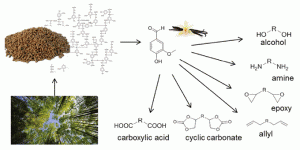 Research by French scientists has identified 18 vanillin derived chemicals for application in the synthesis of bio-based polymers. Vanillin is interesting as a chemical intermediate because of its different functional groups, and because it is manufactured in different ways. Extraction of natural vanillin and fermentation of bio-based ferulic acid are high cost options compared to the petroleum derived synthesis from guaiacol. An alternative route to vanillin has recently been proposed starting from p-cresol, but this approach is also based on non-renewable feedstocks. Another procedure that presently has a minority share of global vanillin production is the valorisation of lignin. This process had fallen out of favour somewhat, but cleaner technologies have revitalised research into vanillin derived from Kraft lignin, benefiting from the growing interest in producing chemicals from lignin more generally.
Research by French scientists has identified 18 vanillin derived chemicals for application in the synthesis of bio-based polymers. Vanillin is interesting as a chemical intermediate because of its different functional groups, and because it is manufactured in different ways. Extraction of natural vanillin and fermentation of bio-based ferulic acid are high cost options compared to the petroleum derived synthesis from guaiacol. An alternative route to vanillin has recently been proposed starting from p-cresol, but this approach is also based on non-renewable feedstocks. Another procedure that presently has a minority share of global vanillin production is the valorisation of lignin. This process had fallen out of favour somewhat, but cleaner technologies have revitalised research into vanillin derived from Kraft lignin, benefiting from the growing interest in producing chemicals from lignin more generally.
Polymers of vanillin are known, but are not often significantly diversified from the parent molecule. This latest work lead by Sylvain Caillol has resulted in the synthesis of difunctionalised epoxides, carbonates, alkenes, alcohols, amines and carboxylic acids, all with obvious potential as monomers for bio-based polymers. Different polymer types have been targeted, including epoxy resins, polyesters and polyurethanes. Through this research a number of opportunities for new and interesting renewable polymers have been opened up, which utilise the abundant resource of lignin via the important chemical intermediate vanillin.
Vanillin, a promising biobased building-block for monomer synthesis
Maxence Fache, Emilie Darroman, Vincent Besse, Auvergne Rémi, Sylvain Caillol and Bernard Boutevin
Green Chem., 2014, Advance Article, DOI: 10.1039/C3GC42613K










